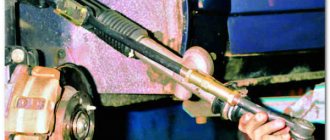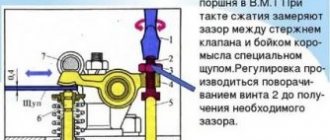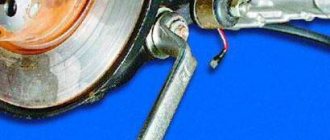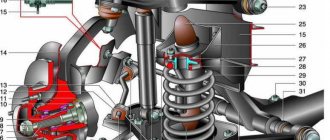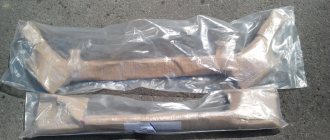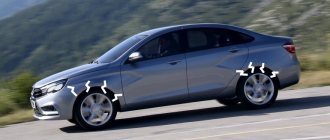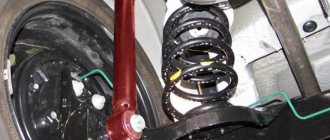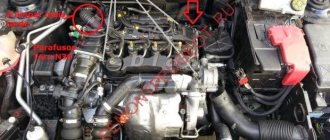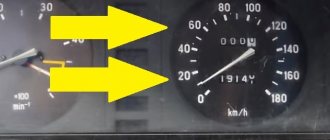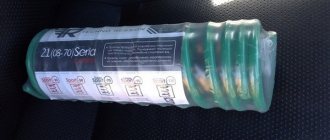16.10.2019
| (Votes: 2, Rating: 3) |
Issues discussed in the material:
- What parts does a car suspension consist of?
- Why do you need to diagnose your car suspension?
- How to check a car suspension on a vibration stand
- How to independently assess the condition of a car's suspension
The suspension, or chassis, is one of the most important systems of a car. While the car is moving, this unit takes on all the unevenness of the road surface and is subjected to significant loads. Reliability and serviceability of chassis parts are important components of safe and comfortable driving. To determine the condition of the chassis, suspension diagnostics must be periodically carried out. We will talk about the features of this procedure in our article.
Suspension structure and main parts
Everyone knows that the roads in Russia are far from ideal. Cracks in the asphalt pavement, holes and potholes cause a lot of complaints from motorists. In addition, more and more speed bumps are appearing. A car suspension absorbs all bumps and imperfections in the road.
When a car drives on an uneven road surface, all bumps are transmitted in the form of vibrations to its body. The connecting link between the body and the wheels is the chassis of the car. One of the tasks of the suspension is to dampen vibrations caused by uneven road surfaces. The design of the chassis is designed in such a way as to allow the wheels to move relative to the body and change the direction of movement of the machine.
An automobile suspension is a complex assembly that includes such elements as:
- Elastic metal parts (springs, springs, torsion bars) and non-metallic components (pneumatic, hydropneumatic, rubber). These elements take the load that occurs when the car overcomes uneven road surfaces and distribute it to the body.
- Damping parts (shock absorbers). Chassis components with a hydraulic, pneumatic or hydropneumatic device dampen vibrations transmitted from elastic parts.
- Guide parts, made in the form of various levers, connect the body to the chassis and determine their possible movement relative to each other.
- Stabilizers that provide lateral stability of the car (an elastic metal rod that serves to connect the chassis to the body, as well as to protect against increased roll of the car while driving).
- Wheel supports (steering knuckles located on the front axle, which take the load from the wheels and transmit it to other elements of the chassis).
- Fastening elements of suspension units and components, which ensure their connection to each other and fastening to the body (bolts, composite silent blocks, ball joints).
The operating principle of the vehicle's chassis is based on the conversion of shock energy, which occurs when the wheel hits various road irregularities, into the movement of elastic parts. At the same time, the movement of such parts is softened by damping elements (shock absorbers), therefore the impact force affecting the car body is softened. This is how the smooth running of the car is maintained. You can get a more visual understanding of the operation of suspension parts by watching a video demonstrating their interaction.
We recommend
“How to improve the suspension (Prior struts) of the VAZ 2110 (10th family)” Read more
The suspension of different car models has different degrees of rigidity. With a stiffer ride, the information content and efficiency of driving the car increases, but the ride comfort significantly decreases. A softer suspension creates increased comfort for the driver, but has a negative impact on the car's handling. The task of car manufacturers' designers is to find the optimal combination of vehicle handling, comfort and safety.
Why do suspension diagnostics?
With regular inspection and repair of your chassis, you will ensure safety and comfortable driving on the road. What is a chassis? It includes a frame, wheels with tires, suspension front and rear. The system for mitigating shocks while driving is under constant load. It takes all the impacts from uneven roads. Due to this, the suspension deteriorates faster if the driver drives aggressively, especially on poorly paved roads.
Why is it useful to carry out preventive diagnostics of the suspension? If problems and minor wear are detected at an early stage, it is easier to prevent more severe damage. You can reduce the cost of car repairs if you make it a rule to regularly inspect your suspension.
- When do you need car suspension diagnostics?
According to the recommendations of experts, a car owner should carry out suspension diagnostics every 10,000–20,000 km or once every six months. It is better to do this before the onset of winter cold, in the spring, or in preparation for a long trip by car.Even if your car was purchased recently or already has minimal mileage, inspection of the chassis must be carried out regularly. If any suspicious noise occurs, the car owner must have it diagnosed.
There are common signs that can help you determine if your vehicle is dangerous and requires technical assistance: strange noises and humming, as well as other unusual sounds while the car is moving. Such signs should alert the driver to impending problems.
If, even after light contact with potholes and other imperfections in the road surface, you notice unusual behavior of the car (it “slides” to the side, noticeable play in the steering wheel appears, etc.), urgently carry out diagnostics of the chassis. It is unsafe to drive such a car; moreover, a faulty car poses a threat to pedestrians and other drivers. There is a possibility of loss of control while driving.
Before purchasing a car, it is recommended to carry out diagnostics of the suspension and its components.
Car repair specialists recommend regularly inspecting the suspension, or better yet, checking the entire car. At the same time, you will not feel a significant difference in money, but you will save time and protect the operation of your car.
Stages of initial car diagnostics: determining the level of suspension reliability, identifying any mechanical damage; checking shock absorbers for leaks, as well as springs for elasticity and serviceability; determining the performance of the steering and the integrity of the CV joint boots; determining the degree of wear of brake discs and pads. For more extensive diagnostics, a computer check of the car’s condition is also carried out.
- How to find out the cause of the problem.
The car driver can pay attention to the appearance of suspension faults while performing various maneuvers. Knocking, noise, sideways drifts, increased braking distance - these are the main signs of problems that are easy to notice. The reasons for their occurrence may be different, but a service station specialist will provide you with more accurate information. The technician will also make the necessary adjustments and perform minor repairs if a problem with the suspension is detected.Please note: if you neglect visits to the service station and do not carry out minor repairs and suspension diagnostics on time, you may find yourself in a situation where your car needs expensive repairs. A car with a faulty chassis can cause accidents on roads.
- Is it possible to do without a service station when diagnosing a chassis?
There are several significant reasons why diagnosing a car’s suspension at home will not be effective. This procedure requires special, expensive equipment, as well as knowledge and some experience in working with technology. We recommend contacting a car service center for help.Minor savings on chassis diagnostics are not advisable. If you don't find an existing problem, it could cost you a lot more or cause an accident on the road.
- Why do you need routine suspension diagnostics? Is it possible to do without it?
Let's define what a car suspension is. The chassis of the vehicle is a system of elements connecting the body and wheels into a single whole. The walker performs an important function. It provides comfortable (without shaking) movement, as well as safety on the road while driving.We recommend
“Diagnostics of a car suspension on a vibration stand: principle of operation” More details
You can neglect the comfort of the car and reduce costs. However, you cannot skimp on travel safety. That is, the reliability and full functionality of the suspension must be observed at every moment of movement.Machine parts and mechanisms wear out over time and require replacement. Diagnostics of the suspension at a car service center helps determine the need for repairs.
Many car enthusiasts believe that the costs of maintaining a car only include purchasing fuel and paying for parking. A competent motorist should allocate a budget for routine diagnostics. This is a small amount that will help you save on repairs in the future.
You may be wondering how a preventive suspension inspection can help you save money? Costs will be reduced due to the fact that you do not spend money on complete and urgent car repairs when the chassis suddenly becomes unusable.
It is problems with the chassis while driving that are the main causes of accidents on the roads. This can lead to big troubles. Basically, in an accident, the body and its components are damaged. Such repairs are more expensive and take longer to fix minor breakdowns. After an accident, you may need the services of a tow truck, polishing or painting the body, replacing car components, etc.
It is recommended to carry out chassis diagnostics at least once a year. However, a responsible motorist conducts such an inspection at least once every six months. Moreover, the price for such a service as suspension diagnostics is quite low.
When checking a car, all components of the chassis are inspected: brake pads, discs and drums, bearings, the tightness of shock absorbers, springs, play in steering tips is checked, the performance of clutches is assessed, and much more.
Such a wide diagnostics of the chassis and all car systems helps to determine the technical condition of the car and plan preventative repairs.
What problems cannot be put off until later?
Driving a car with broken suspension is a bad idea. The driver must understand that he is exposing himself to a certain danger. There are many solutions that can be used in a variety of situations. If you discover a simple problem, but don’t have a lot of money for repairs, you can temporarily install cheap Chinese spare parts and give yourself several months of safe operation of the car. But it’s better not to joke with the following breakdown options:
- everything related to the racks and their fastenings - failure will completely prevent you from operating the car, and may also damage some surrounding parts;
- CV joints and their fastening mechanisms - they should be changed immediately after the knocking starts, since their complete destruction will lead to the fact that movement is impossible and the torque will not be distributed;
- steering system, ends and rods - these should also be replaced as soon as you discover problems, since failure to replace them will put you in danger;
- the braking system does not tolerate any delays, so it is worth repairing and restoring it immediately after diagnosing and detecting any breakdowns;
- Rear suspension parts, as a rule, can wait, but if this does not concern the wheel bearings, these parts should be changed in a timely manner to avoid various troubles.
Checking the wheel bearing is incredibly simple - you just need to accelerate to a speed of 90 kilometers per hour and try to hear the hum from the front and rear suspension. If there is a hum, you can safely change the bearing on a certain side. If there is no hum, nothing needs to be changed. You can also jack up the wheel and try to spin it as much as possible to obtain information about the bearings and their condition.
Suspension diagnostic options
There are three main options for diagnosing a car’s suspension:
- Before buying: a used car is checked before completing a purchase/sale transaction.
- Preventive (routine) diagnostics are carried out regardless of the condition of the car. It is planned for a specific date. For example, before the winter cold, before a long trip.
- An emergency (emergency) check of the chassis is carried out if, when the car is moving, a hum, unusual noise or clanging is heard when turning the steering wheel. Car instability at high speeds, skidding on turns, “jumping” on bumps and holes. When braking, the vehicle deviates to the side, and when accelerating, the steering wheel “goes” to the side. This means that the suspension has worn out, and driving such a car is dangerous and uncomfortable. Urgent repairs are needed.
Of course, in any of the above options, suspension diagnostics are carried out using the same methods. With certain knowledge, this procedure can be carried out independently. However, if you do not involve a specialist, you need to know exactly what, where and how to inspect.
How to check your suspension yourself
From the outside it may seem that diagnosing the suspension of a modern car is a complex process that requires special knowledge and professional equipment. But every driver can perform a simple inspection of the chassis of his car. We will tell you how to do this in this section.
- How to check the front suspension.
Many car models are equipped with a standard McPherson front suspension. The most expensive structural elements of such a “walker” are the struts and shock absorbers. From the point of view of the complexity of the replacement process, it is worth highlighting the silent blocks of the stabilizer and levers. The most affordable and easiest to dismantle/install parts of the front suspension are ball joints.Self-diagnosis of the front suspension should begin with an inspection of the anthers and rubber protection elements of the chassis parts. It is worth checking the silent blocks and ball joints. It is also necessary to check the fastening bolts and steering ends. If parts with damaged anthers are identified, such components will need to be replaced.
You should carefully inspect all rubber suspension seals. There should be no visible mechanical damage. Then it is necessary to inspect the parts that are attached to the body. Difficulties may arise here due to poor visibility.
Oil leaks may indicate a faulty shock absorber. Most often, they appear even earlier than the sounds when the car rocks. If car vibrations are not damped effectively enough, it means that the shock absorbers are already too worn out and need to be replaced urgently.
- Determine the problem by eye.
Severely worn car suspension springs sag, so to identify this malfunction you need to carefully inspect the car, paying attention to its fit. If the body is lowered lower than usual, this may indicate “fatigue” of the shock absorber springs. With such a malfunction, it is impossible to correctly adjust the wheel alignment.To diagnose ball joints, you will need an inspection hole, as well as a mount. Using the latter, you need to press the silent blocks of the lower arms and check whether they can move up and down. The serviceability of the part is indicated by the absence of play, as well as mechanical damage on the rubber surface.
Checking the strut bearings is a simpler procedure. To do this, rock the car down and up. If the bearings wear out, play will be noticeable. Experts note that if these parts are worn out, the car will rock more than once after rocking up/down.
- Behind the wheel and on the move.
A number of suspension faults can be diagnosed while driving or when the car is stationary and you are driving. By turning the steering wheel from side to side, you will check the operation of the steering rack. As a rule, problems with this unit are associated with wear of the guide bushing.By rotating the steering wheel from side to side, you can also diagnose faulty steering tips and rods. For this procedure, you will need the help of an assistant who will hold the rods and tips, checking for any play. If a gap is detected, the faulty parts must be replaced.
Wheel bearing diagnostics are carried out while the machine is moving. A worn bearing will make a loud and even noise when the wheel rotates. This sound will be heard even if the car interior is well soundproofed. Another option for checking the condition of wheel bearings involves hanging the wheels on a jack. The suspended wheel must be rotated by hand or rocked, applying force at the top point to reveal the play.
We recommend
“Elements of a car’s suspension: types and tasks to be solved” More details
If you decide to diagnose the suspension yourself, do not forget to check the external constant velocity joints (CV joints). If faulty, they will make a crunching sound when accelerating on sharp turns. - How to check the rear suspension.
The main structural elements of the chassis relate to the front suspension, so making an independent diagnosis of the rear suspension is not so difficult. For most budget car models that use independent suspension, the most expensive element in the rear of the chassis is the struts. On average, this part “runs” about 100,000 km.In addition to shock absorbers, there are no other important parts in the rear part of the independent suspension that affect the technical condition of the chassis. The rear silent blocks practically do not fail, but it is worth checking their condition. The dependent suspension is a more complex device, but here the most important elements are the struts and silent blocks. True, in this case the latter wear out faster.
Diagnostics of the rear suspension is carried out along with checking the entire chassis during a test drive. Signs of a malfunction of its parts are extraneous sounds and excessive rocking of the car body. If, while driving on an uneven road, the car sways not only up/down, but also to the sides, then this indicates the need for urgent repairs. If such behavior of the suspension is revealed when checking a car before purchasing, then the conclusion arises that the previous owner did not monitor the condition of the car, and it is better not to buy it.
Stabilizer bushings and struts
To check these elements of the chassis, you can rock the body in the transverse direction together with an assistant, grasping the roof on both sides. If knocking noises appear during such a build-up, this may indicate a malfunction.
Sounds that arise when rocking slightly behind may indicate a loose exhaust system of the car.
To clarify the diagnosis, you need to swing the exhaust pipe from side to side with the car standing still. If there are no knocks during this procedure, one can suspect that the main cause of such noise is the rear stabilizer hinges.
By performing these simple steps, you can check the basic elements of the suspension of a modern car. Regular do-it-yourself diagnostics of a car's chassis is available to most car enthusiasts.
This does not require you to have any special skills or abilities. In this case, you do not need to use special tools, a jack, an inspection hole or a lift. The condition of the suspension can be determined almost with bare hands.
